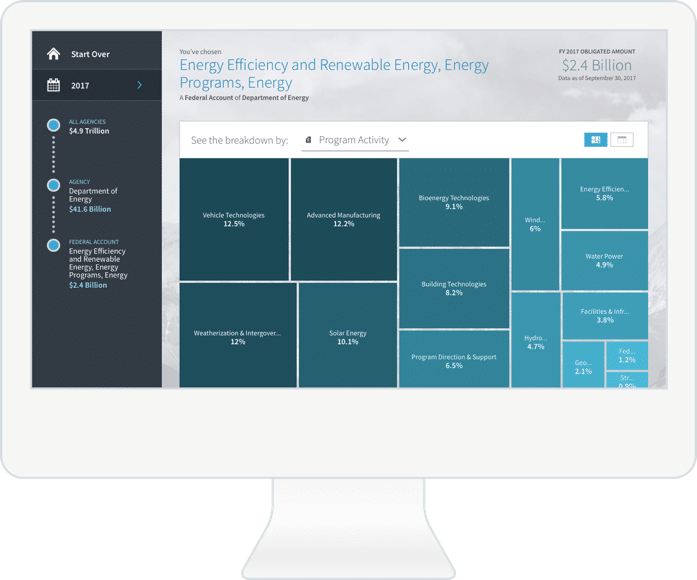 Exclusive
Exclusive Exclusive
‘Data + Use = Value’ is the motto for new USASpending.gov
The Treasury Department is launching a series of new data analysis tools to let people have access to a treasure trove of contracts, grants and other spending...
Best listening experience is on Chrome, Firefox or Safari. Subscribe to Federal Drive’s daily audio interviews on Apple Podcasts or PodcastOne.
If there is one thing the USASpending.gov portal always had was data. But what it did not have ever since the Office of Management and Budget launched the site in 2007 was the ability to analyze said data.
That is, until now.
The Treasury Department’s Bureau of Fiscal Service is launching a series of new data analysis tools to let citizens, businesses, the media and maybe most importantly, so-called “data geeks” have access to a treasure trove of contracts, grants and other spending information like never before.
“We have a new initiative called data lab where we are posting analytics and visualization to help inspire researchers, data scientists and members of the public to understand what this data is and to think of own use cases for it,” said Justin Marsico, a senior policy analyst with the Bureau of Fiscal Service in an exclusive interview with Federal News Radio. “We also have redesigned the USASpending.gov site to be more accessible, friendly and easy to understand and use for members of the public and for federal agencies.”
The new features on the site can be traced directly back to the Digital Accountability and Transparency Act (DATA Act). Over the last nearly four years — May 9 will be the law’s fourth anniversary — agencies have been aligning data around 57 standard definitions.
“The revamped site and Data Lab provide greater insights, accountability and oversight into $3.98 trillion of government spending last year alone,” said Hudson Hollister, executive director of the Data Coalition, in a statement. “We are encouraged by the progress and recognize that agencies must continue to improve the quality of their data submissions in accordance with the law’s requirements.”
Now that those standards are widely used, USASpending can take advantage of them in new ways.
“One of the primary things we have now is a lot more data than we had before on the old site. The key difference is we have data on how agencies spend money in their federal accounts,” Marsico said. “We have over 90 agencies that are submitting data on how they spend money against their federal accounts in a uniform way. That does a couple of things to increase transparency. First, it gives every member of the public and people who work in those agencies, a view into what agencies are spending and what they are spending money on. It also for the first time, links those contracts and grants that we always had to the accounts that fund them. That allows you to understand a little bit more about the contracts and grants themselves by understanding not only the accounts that are funding them, but the programs they are supporting.”
By letting citizens, contractors and researchers track spending down to the account level, USASpending.gov uncovers, for really the first time, the trail that goes from Congress appropriating dollars to a specific part of an agency to awarding of those funds to private sector.

Marsico said a new tool called the spending explorer that lets users pull data at the agency level or by budget function, like transportation or energy that multiple agencies receive funding.
He used energy as an example where a user could get to a federal account, then to a program, say devoted to solar energy, and see how the Energy Department is spending money on contracts and grants. Then, the user can drill down further into contracts and see all contracts for solar energy.
Marsico said on the old USASpending.gov site a user could find those contracts, but it wasn’t as easy and there was no linkage to where the funds came from in Congress.
“From the beginning, we took an approach of focusing on the data as opposed to focusing on the system. With this data-centric approach, we were able to say this is exactly the kind of data that we want to have to make it usable for people in the end. We have a saying here on the team, ‘data + use = value.’ We are trying to maximize the use,” he said. “With that approach, agencies were able to figure out how to implement those changes to improve financial management system to produce this data to Treasury. We also have a number of validations that we apply to the data as it comes in to make sure there are some basic rules that are followed and that helps to ensure the data quality.”
The bureau first updated the USASpending site in May 2017 to begin showing how the information under the DATA Act could be used.
These recent updates continue to build on Treasury’s efforts to try to improve USASpending.gov since it was initially launched in 2007 by an unenthusiastic Office of Management and Budget.
The DATA Act also is solving another long-standing problem with USASpending.gov — data inaccuracies. The Government Accountability Office found several times over the last decade that the portal’s data was problematic.
Along with the spending explore, the bureau also launched six visualization tools to help make the information more transparent.
The tools include letting users conduct analyses on contracting data, federal account data and grants data specifically around how agencies are helping those how are homeless.
The new tools also lets users search contract data by vendor in new ways.
Marsico said the data lab gives users the total number of dollars that have been obligated to a specific contractor as well as the visualization of which agencies and sub-agencies that awarded those contracts.
“We are also working right now on a recipient profile page that will be part of the main USASpending.gov page. When you look up a specific entity, you will be able to see all kinds of detailed information about the different awards that entity has received over a specific period of time,” he said.
The bureau is using open source tools, such as JavaScript D3, for the visualization to make the data easier to use.
Marsico said all the code is available in the USASpending.gov Github library, meaning developers could use the tools for their own use cases.
“We have tried to design our tools so they can be used by anybody,” he said. “The way we have tried to accomplish that is by really taking to heart the principles of user-centered design. What that means for us is we design a tool, we put it in front of someone and watch them use it. We do formal interviews with users as they use it. We record the interview. We review them and see where people are confused and try to address those points of confusion by changing the analyses and adding helper tools.”
He added that user testing experience can be humbling because the user’s critique may be the opposite of what the bureau initially planned.
“That’s a difficult experience to have but a good one to have because it forces you to go back and make changes and approve so by the time you put something out to the public it’s the best iteration you can come up with,” he said.
The bureau will continue to modernize USASpending.gov platform with new tools and capabilities.
Marsico said his office sees the portal as a dynamic site that will change based on user feedback and needs.
“We want to continue to add analyses to the data lab. We also are thinking about how to create guidance and helpful tips and tricks for using the data from everything we’ve learned,” he said. “We are investing in transparency for the public. We want to explain what the government is doing by showing how it is spending money and we want to do a better job at that. Our motto here is better data, better decisions, better government and we really take that to heart. We hope that people see that when they go to the new USASpending site.”
Copyright © 2025 Federal News Network. All rights reserved. This website is not intended for users located within the European Economic Area.
Jason Miller is executive editor of Federal News Network and directs news coverage on the people, policy and programs of the federal government.
Follow @jmillerWFED
Related Stories

DATA Act’s ‘gentle transition’ offers agencies option to dive in, dip toe in data

No surprise: Agencies taking small, slow steps to improve reporting of spending data




